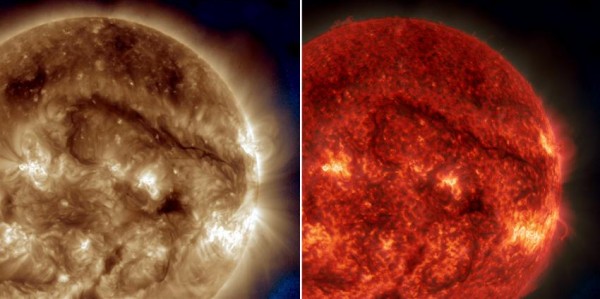SDO Monitors Giant Sun Filament
| Marc Maligalig | | Oct 04, 2014 05:52 AM EDT |
(Photo : NASA/SDO)
The National Aeronautics and Space Administration's Solar Dynamics Observatory, or SDO, has observed a gigantic filament on the surface of the sun over the course of several days.
The snaking filament lies on the surface of the Sun facing Earth. If stretched out in a straight line, it is estimated to be 100 million miles across from end to end, and would be able to reach around the whole star. The equivalent distance on earth is about a hundred trips around the world.
Like Us on Facebook
Filaments are clouds of solar material that are suspended by the powerful magnetic forces of the star. They can last from days to even weeks, even if filaments are found to be highly unstable.
The SDO was able to take images of the filaments in various wavelengths, each of which sheds light on the temperatures of the different materials on the sun. Scientists can learn more regarding the causes of such structures and what catalyzes their sporadic eruptions into space by looking at the solar features in various temperatures and wavelengths.
Meanwhile, another solar phenomenon was spotted in the previous month that affected radio communications in the Earth's upper atmosphere, although the disruption was small.
At 1:46 p.m. on Sept. 10, the turbulent Sun unleashed a powerful solar flare aimed at the Earth.
The SDO recorded the flare, which was classified as an X1.6, a powerful rating.
"Impacts to HF (high frequency) radio communications on the daylight side of Earth lasted for a little more than an hour," said the NOAA Space Weather Prediction Center in a bulletin.
If radiation from an X-class flare reaches the planet's ionosphere, extreme-ultraviolet light and X-rays could significantly affect radio waves used for communication.
On the other hand, the biosphere, the region of the planet that supports life, is mostly unaffected because the flare's energy is absorbed by the atmosphere.
TagsSun, NASA, SDO, National Aeronautics and Space Administration, Solar filament, filament, Solar Flare
©2015 Chinatopix All rights reserved. Do not reproduce without permission
EDITOR'S PICKS
-

Did the Trump administration just announce plans for a trade war with ‘hostile’ China and Russia?
-

US Senate passes Taiwan travel bill slammed by China
-

As Yan Sihong’s family grieves, here are other Chinese students who went missing abroad. Some have never been found
-

Beijing blasts Western critics who ‘smear China’ with the term sharp power
-

China Envoy Seeks to Defuse Tensions With U.S. as a Trade War Brews
-

Singapore's Deputy PM Provides Bitcoin Vote of Confidence Amid China's Blanket Bans
-

China warns investors over risks in overseas virtual currency trading
-

Chinese government most trustworthy: survey
-

Kashima Antlers On Course For Back-To-Back Titles
MOST POPULAR
LATEST NEWS
Zhou Yongkang: China's Former Security Chief Sentenced to Life in Prison

China's former Chief of the Ministry of Public Security, Zhou Yongkang, has been given a life sentence after he was found guilty of abusing his office, bribery and deliberately ... Full Article
TRENDING STORY

China Pork Prices Expected to Stabilize As The Supplies Recover

Elephone P9000 Smartphone is now on Sale on Amazon India

There's a Big Chance Cliffhangers Won't Still Be Resolved When Grey's Anatomy Season 13 Returns

Supreme Court Ruled on Samsung vs Apple Dispute for Patent Infringement

Microsoft Surface Pro 5 Rumors and Release Date: What is the Latest?










